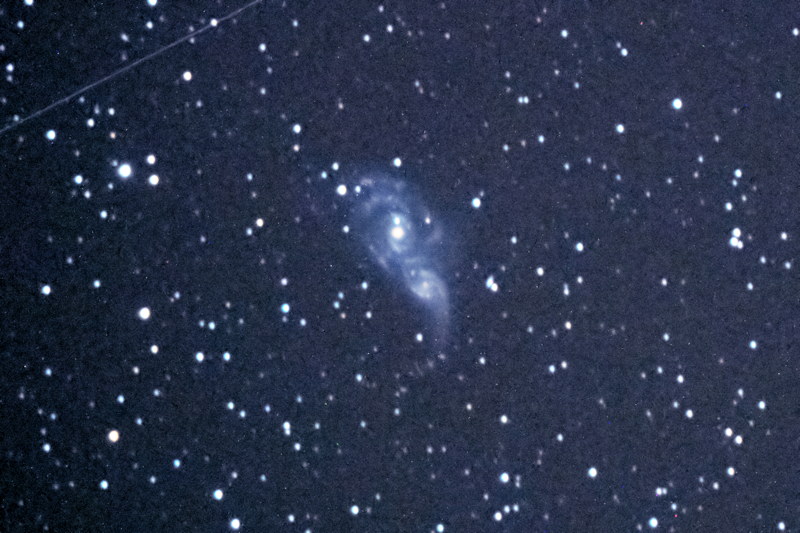
D7000 DSLR DSO Imaging: NGC2207, M42, M63, NGC4038
Posted: 22 February 2012
After my 8 hour session in the observatory 18-19 February, clouds returned and kept me from the observatory until Tuesday, 21 February, when the sky cleared up again. I opened the observatory at 1809 MST, 73°F. Beginning at 1813 MST, viewed Venus, Mercury, and Jupiter at 77X. At 1844 MST, while waiting for twilight to end, I began preparing the Nikon D7000 DSLR for imaging at the 8" LX200-ACF prime focus using the Off-Axis Guider (OAG). At 1849 MST, the camera was ready. I slewed to M42, the Great Orion Nebula, and began waiting for the sky to darken. The Trapezium star cluster was very nice against the still bright sky background at 77X, 133X, and 206X. At 1904 MST, I slewed to NGC2207, a faint galaxy, which would be my first DSO imaging target for the night. The galaxy became visible at 1911 MST in the 26mm (77X) eyepiece. I then slewed to the star Sirius, mounted the camera at prime focus, and attached the Bahtinov Mask. After doing the focus test image, I went back to NGC2207 and did several framing test exposures, 1 minute, ISO 6400, while searching for a good guide star. I found a good guide star and did 5 and 10 minute, guided, exposures. This is the 10 minute, cropped, exposure of NGC2207:

Next, I slewed to M42 and began a series of guided exposures at ISO 6400, ranging from 10 seconds to 3 minutes. This is the 10 second, full-frame, exposure:

This is the 3 minute, full-frame, exposure:

As seen in the photos, the central Trapezium area is well exposed at 10 seconds but extremely overexposed at 3 minutes. I merged these two images in Photoshop Elements 9 to yield this image:

I ended imaging at 2014 MST and removed the camera from the telescope. At 2029 MST, I viewed Mars at 77X. It was still too low for good viewing but the North Polar Cap and a dark area were visible.
At 2043 MST, slewed to M63, the Sunflower Galaxy. I needed to re-image it since my guiding during the exposure was not precise on my last session. The galaxy was too low in the northeast for good viewing at 77X and the neighbor to the northeast was currently making his contribution to the global light pollution problem. At 2059 MST, while waiting for M63 to rise higher, I viewed M1, the Crab Nebula, high in the sky, at 77X and 133X. Its structure and some details were seen. I then took another look at Mars.
At 2140 MST, the neighbor had finished his contribution. Mars was higher in the sky now but seeing was not good. I went back to M63. At 2208 MST, slewed to the star Regulus to do a focus test image with the Bahtinov Mask. Mounted the D7000 at prime focus with the OAG. I then returned to M63 for a series of framing test exposures while searching for a good guide star. I could not find a suitable star so I rotated the OAG. That required another Regulus focus test exposure with the Mask. That done, I returned to M63 and repeated the search for a guide star and found a faint one that provided good framing of M63. I then captured this guided 5 minute, ISO 6400, cropped image of M63, the Sunflower Galaxy:

At 2306 MST, slewed to NGC4038, the Antennae Galaxies, my next DSO imaging target. I wanted to try a longer exposure than I did on the previous session. I immediately found a good guide star with fair framing of the galaxies in the camera FOV. While waiting for the DSO to get higher in the sky, I found a better guide star with excellent framing of the galaxies. I finally captured this guided 10 minute, ISO 5000, slightly cropped image of NGC4038:

Some of the fainter arms to the lower left and upper right of the galaxies are just barely visible in the image.
At 0002 MST, I ended imaging for the night. I viewed NGC4038, the Antennae Galaxies at 77X. Some of the structure was visible. I then viewed Mars at 77X, 133X, 206X, and 364X. Unfortunately, even with Mars much higher in the sky now, seeing had not improved.Closed the observatory at 0026 MST, 46°F. A nice 6 hour and 17 minute session.
Go to the previous report.
Return to the Cassiopeia Observatory Welcome Page.